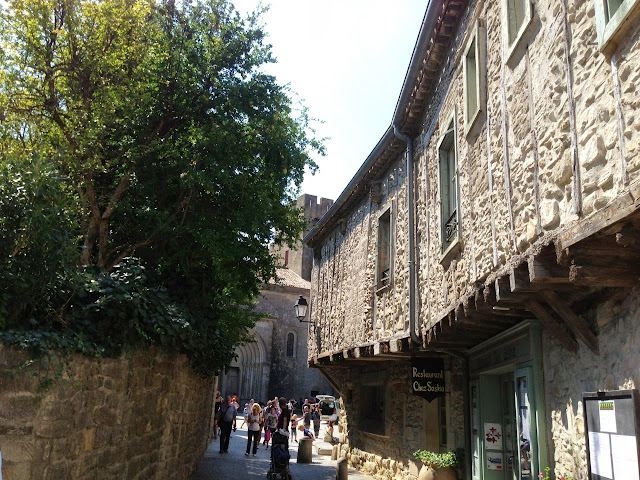One of the little highlights of our holiday is a week in the lovely medieval French village of Collioure, almost on the Spanish border and sitting in a bay where the mighty Pyrenees tumble into the sea.
On the way to Collioure we stopped off in Carcassonne to look at a nearby poperty (not a goer, I'm afraid) and so decided to pay another visit to la Cité, the fortified city of Carcassonne. This is a UNESCO World Heritage site.
Since the pre-Roman period, a fortified settlement has
existed on the hill where Carcassonne now stands. In its present form it is an
outstanding example of a medieval fortified town, with its massive defences
encircling the castle and the surrounding buildings, its streets and its fine
Gothic cathedral. Carcassonne is also of exceptional importance because of the
lengthy restoration campaign undertaken by Viollet-le-Duc, one
of the founders of the modern science of conservation.
Such was the impregnability of Carcassonne that it was never attacked during the Hundred Years' War, even during the Black Prince's raid in 1355 (sounds dramatic, eh?). The Huguenots made two surprise attempts to seize the town by force in 1575 and 1585, but both were quickly repressed. It became an arsenal and supply depot during the Ancien Regime and again during the Revolution. It was removed from the list of military fortresses in 1804, then reinstated as a second-grade fortress in 1820.
As a result of this lack of committment it was quickly treated as a convenient stone
quarry and its walls and towers began to be dismantled. The survival of this
magnificent set of fortifications owes its salvation to J P Cros Mayrevieille, who succeeded in 1850 in having the decree that abandoned the
defences to demolition annulled. Prosper M6rim6e, at that time Inspecteur
General des Monuments Historiques, began discussions with the War Ministry to
save the ramparts, and the first funds were made available for this purpose in
1852.
Eugene-Emmanuel Viollet-Ie-Duc, who had been commissioned to prepare a report as early as 1846, began his restoration work at the Porte Narbonnaise and the Porte de l' Aude, and continued working at Carcassonne until his death in 1879. During this time the internal fortifications were almost entirely restored, along with a number of the towers on the external defences.
In the last part of the century his successor Paul Boeswillwald removed the houses that had been constructed within the area between the two lines of walls and continued working on the restoration of the walls and the castle. The restoration process was not completed until 1910.
This is the 12th-century count's castle that was built over the western
part of the Roman walls; it was surrounded by a rectangular fortified enclosure
in 1226. By the end of the 13th century the town had assumed its definitive
appearance as a medieval fortress. A local revolt in 1262 caused the king to
expel most of the inhabitants. He allowed them to settle on the other side of
the river, where the new town that they set up was itself fortified in 1347.
Enough official history!
We went into the cathedral inside the walls of the city and were serenaded by these three serious young men. You wouldn't believe the sounds that came out of their mouths and the fabulous acoustics of this church.
In order to keep the city operational, financially viable and in good working condition, a lot of tourist related commerce has been encouraged such as B&Bs, hotels, restaurants, cafes, retail shops of all types and of course the souvenir shops.
This immaculately dressed gent was guarding the lolly shop!









No comments:
Post a Comment